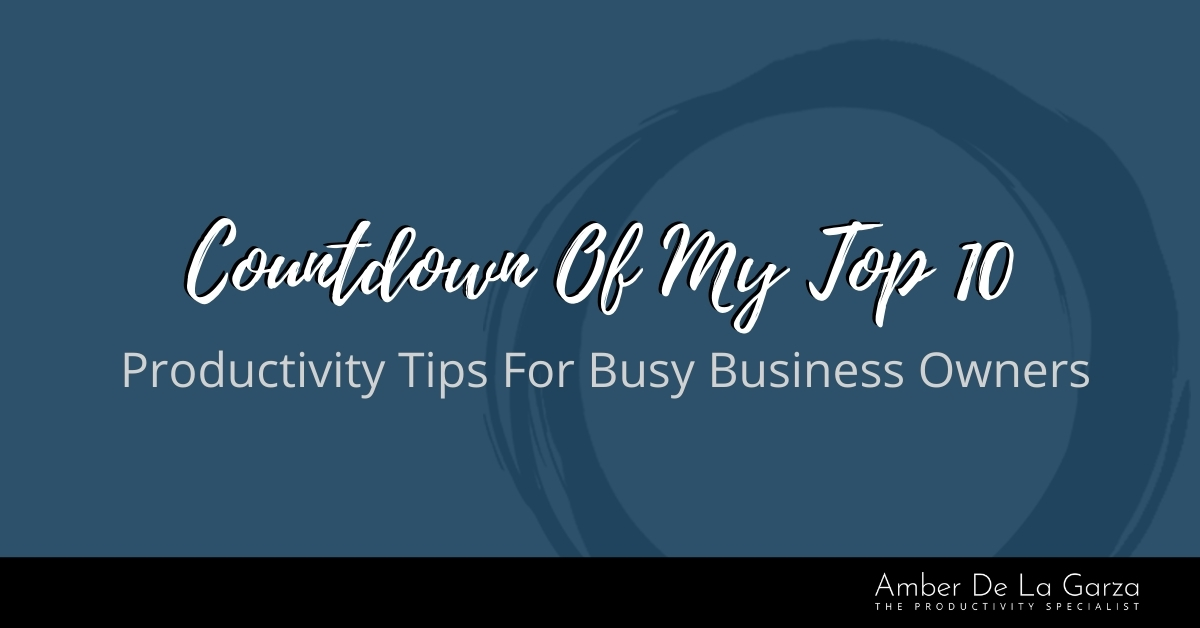Do you consider yourself a busy business owner? Perhaps too busy? If you're like most of the business owners I work with, you would love having the time and energy to grow your business while also having the time and energy for what matters most outside your career - your relationships, hobbies, and passions - but you're currently too busy and too overwhelmed for either. The solution is improving your productivity! The internet is full of tips on how to lose weight, create your own hair mask, fix a computer issue, and don’t even get me started on the vortex that is kids birthday party ideas. The internet is also stocked with tips on how to improve your productivity, so many though, that choosing which ones to implement in your small business could be overwhelming.
Knowing that everyone is different when it comes to their best ways of being productive, I came up with a countdown of my top 10 productivity tips for busy business owners that can easily be implemented and tweaked to work for your business and workflow, regardless of your skillsets. Stop surfing the internet for answers to your productivity woes and start implementing these tips as a solid foundation to improve your productivity by leaps and bounds!
Countdown Of My Top 10 Productivity Tips For Small Business Owners
10. Create Clearly Defined Goals
As Stephen Covey says, “You must begin with the end in mind.” That statement holds true for every project you undertake and every goal you set out to achieve. If you don’t know where you are heading, every shiny object/project/opportunity/app/program will look like a great thing to spend your time on. You can steer clear of getting sidetracked by setting goals, aligning your activities to match, and staying focused on pursuing them.
Once you've created clearly defined goals for your small business, use the powerful goal setting strategy of taking them from good to better to best, then break them down into smaller, actionable milestones that you can actually wrap your mind around and ultimately achieve. Finally, identify what metrics you can use to track your progress and help you determine if you're being productive and staying on track toward your larger goal.
9. Stop Multitasking
As work environments become increasingly more demanding, it only makes sense that if we want to be efficient and productive, we should attempt to excel at multitasking, right? Wrong! The problem is attempting to multitask risks our most valuable asset, time, because multitasking is a lie. Human beings are incapable of doing two activities at once and doing them both well. When you think you are multitasking you are actually just switchtasking which is alternating back and forth between tasks rapidly, neither of which are receiving your full attention.
When you buy into the lie of multitasking you are condemning yourself to feeling overwhelmed, inaccuracies in your work, and poor communication with others. Being efficient requires you to focus on one activity at a time so all of your effort and brainpower can be concentrated on accomplishing that one activity well. Complete one task then move on to the next for maximum productivity.
8. Utilize A Digital Task List
Creating a task list forces you to get all of the to-dos out of your head and enables you to determine which ones must be completed first. Stress comes from the feeling of not knowing what needs to be done and not being able to complete everything but you don’t need to do everything – at least not right now! You just need to complete your priority tasks and projects. Other tasks can wait and should be prioritized that way. Utilizing a digital task list instead of the old school paper task list enables you to prioritize with ease and most effectively and efficiently manage your abundance of tasks.
Still not convinced? Here are some other great benefits of going digital with your task list:
7. Upgrade Your Technology
If your technology has become slow or ineffective over time, it could be the arch-nemesis to your productivity. Settling for less in your business costs you time, energy, money, lost opportunities, and clients. Don’t wait until it is too late and you’ve completely lost working efficiently altogether. Upgrade your technology as needed. That may mean buying a new hard drive, printer, or phone so you can work on the go. Stop settling for less when you and your business deserve MORE!
Do not attempt a complete technology overhaul all at once because taking on that monstrous task would overwhelm you. Make a point to upgrade only one system or technology in your business at a time. Get it set up and functioning properly, then move on to the next needed upgrade. Especially consider upgrading your task management system if yours is not keeping up with the growing technological demands of running a business with all of its moving parts. If you're a one-man or one-woman show, Trello might meet your task management needs, but if you have a team, consider a more robust project and task management system like Clickup. You can read my full review on Clickup for small businesses here.
6. Process Emails
The average number of business emails sent & received per day in 2019 was 126. That's nearly 50,000 emails per year! Like most business owners, you likely lose emails, information, and opportunities as a direct result of receiving so many emails yet not deciding to act upon them. Scanning through emails, many of which are unwanted, and leaving many of them to deal with “later” or perhaps “cherry-picking” which emails to respond to results in greater stress, cluttered inbox, missed emails and opportunities, and overlooked tasks. Checking emails throughout the day is a costly mistake. Stop checking your emails and start processing them instead. Schedule a block of time each day to process your emails which means taking one of the following actions on each and every email the first (and only) time you open it:
If your lack of effective email management has caused chaos and stress in your business and life, check out my Conquer Your Email Masterclass which will help you process your emails like a pro, organize your hot mess of an inbox, and take back control of it once and for all!
5. Create An Environment That Supports Your Productivity
Unless you thrive in a disorganized environment and are most efficient when surrounded by clutter, your workspace needs to be organized, free of clutter, and used solely for work. For most small business owners, disorganization and visual clutter are very distracting and create a feeling of being overwhelmed. If your workspace is a mess, it’s hard for your mind to not be. An organized workspace enables you to focus on the task at hand and decrease the amount of time it takes to complete each activity. It also helps you find needed items much more quickly.
An added bonus of keeping an organized workspace is that it portrays a high level of professionalism. Why would a client trust you with their important files if you can’t even maintain your own? Organize your workspace to let it best represent you and the highly professional business you are running. Also, consider how else you could design your environment to better support your productivity. Perhaps you could get in and stay in your focused zone more easily if your office were quieter, warmer, or darker. Identify your physical productivity sweet spot and recreate it every time you work.
4. Take Breaks
Working through breaks may feel like a productive use of your time but it’s not. It’s important to take scheduled breaks so you can return to work with a fresh pair of eyes and renewed focus. Walking away from your work reenergizes you to be able to complete tasks with increased focus so taking breaks throughout the day is essential.
A break can be any activity that relaxes, re-energizes, or relieves stress and is a important factor in self-care. Eating a healthy snack, stretching, taking a brisk walk, reading an industry magazine, and making a personal phone call are examples of ways you can take a short break to rest your mind for a moment. Schedule at least a couple of breaks into your workday, otherwise you're only sabotaging your productivity.
3. Time Block
Time blocking is a powerful strategy to promote focus that involves purposefully allocating chunks of time to completing a specific task or project. Essentially, time blocking means creating smaller, task / project-based goals for your time. If you don’t utilize time blocking, you may never 'find the time' to complete some of your high-priority tasks or projects so they wind up staying on the backburner until they fizzle out or keep begging your attention away from what you are working on. If you want something done, put it on your calendar!
To effectively time block your high-priority activities, identify the best times you have open in which you can get focused work done. Plan out periods of around 60 – 90 minutes on your calendar and label them as the project or task name, then schedule all of your other, lower-priority tasks around those times. Hold those blocked-out times with yourself sacred because time blocking can only work if you stay committed to actually doing the work. To see the full benefit, you must hold the meeting with yourself as you would a meeting with your client, including following the rules of no phone calls, emails, internet surfing, or other distractions and interruptions.
2. Just Say No
Peter Drucker wisely said, “There is nothing as useless as doing efficiently that which should not be done at all,” and he’s right. Like most small business owners, you probably overcommit yourself often to activities and distractions dressed up as opportunities that don’t bring you any closer to your goals or vision of success. Time is your most valuable asset so it is important to eliminate those activities that aren't serving you. Eliminating is essential to free yourself up to spend your time and energy on your high-priority activities and that often means having to say no.
According to Warren Buffett, "The difference between successful people and unsuccessful people, is that really successful people say no to almost everything." To determine if a proposed activity or meeting is worth your time, filter it against your goals. If it’s not, choose one of these two options: delete it or delegate it.
1. Being Productive Is A Choice
Being productive all comes down to this… you must consistently invest your best time into your best activities! Many people think they’re either born productive or not, as if being productive is some sort of recessive trait like blue eyes. They think they can’t improve their productivity and they’re wrong. Being productive is a choice and contrary to popular belief, productivity is not about getting everything done or being busy! It is about getting done the activities that bring you closer to achieving your goals and vision of success, and anyone can do it! Prioritize your tasks so you can purposefully allocate the majority of your time and energy to your high-priority tasks – those which align with your goals, increase your profitability, and only you can do, then consistently make the choice to show up and complete them. That is true productivity.
When you invest your resources in the right activities, you will be more effective, more efficient, and reap the benefits of being more productive. Implement all of my Top 10 Productivity Tips For Busy Business Owners, tweak them to work for your business and workflow, and consistently utilize them to also decrease your stress, grow your business, and free up time for the relationships, hobbies, and passions that make your personal life fulfilling!


